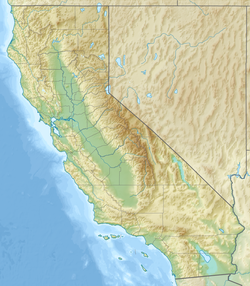Mount Ritter
| Mount Ritter | |
|---|---|
 Mount Ritter (on the left) from the John Muir Trail | |
| Highest point | |
| Elevation | 13,149 ft (4,008 m) NAVD 88[1] |
| Prominence | 3,957 ft (1,206 m)[1] |
| Parent peak | Red Slate Mountain[1] |
| Listing |
|
| Coordinates | 37°41′22″N 119°11′57″W / 37.689378°N 119.1990298°W[3] |
| Geography | |
| Location | Ansel Adams Wilderness, Madera County, California, U.S. |
| Parent range | Ritter Range, Sierra Nevada |
| Topo map | USGS Mount Ritter |
| Geology | |
| Rock age | Cretaceous |
| Mountain type | Metavolcanic rock |
| Climbing | |
| First ascent | 1872 by John Muir[4] |
| Easiest route | Snow/rock scramble |
Mount Ritter is the highest mountain in Madera County, California, in the Western United States, at an elevation of 13,149 feet (4,008 m). It is also the highest and most prominent peak of its namesake, the Ritter Range, a subrange of the Sierra Nevada in the Ansel Adams Wilderness of the Inyo and Sierra National Forests. Mount Ritter is the 15th highest mountain peak in California with at least 500 meters of topographic prominence.
Geography
[edit]Mount Ritter is made of strikingly dark rock and is quite prominent due to its height and isolation.[1] It is in the middle of the Ritter Range, which includes neighboring Banner Peak and the Minarets. The prominent and memorable shape of the Ritter–Banner pair is visible from high elevations far to the north and south in the Sierra Nevada.
Mount Ritter was named by Josiah Whitney, chief of the California Geological Survey, for Carl Ritter, who had been a teacher of his when he was a student in Berlin during the 1840s.[5]
Climate
[edit]| Climate data for Mount Ritter 37.6852 N, 119.2000 W, Elevation: 12,306 ft (3,751 m) (1991–2020 normals) | |||||||||||||
|---|---|---|---|---|---|---|---|---|---|---|---|---|---|
| Month | Jan | Feb | Mar | Apr | May | Jun | Jul | Aug | Sep | Oct | Nov | Dec | Year |
| Mean daily maximum °F (°C) | 28.7 (−1.8) |
27.4 (−2.6) |
30.1 (−1.1) |
34.3 (1.3) |
41.9 (5.5) |
51.5 (10.8) |
59.4 (15.2) |
58.9 (14.9) |
53.4 (11.9) |
44.6 (7.0) |
34.8 (1.6) |
28.6 (−1.9) |
41.1 (5.1) |
| Daily mean °F (°C) | 19.3 (−7.1) |
17.4 (−8.1) |
19.6 (−6.9) |
22.7 (−5.2) |
29.7 (−1.3) |
39.1 (3.9) |
46.5 (8.1) |
45.8 (7.7) |
40.5 (4.7) |
32.6 (0.3) |
24.9 (−3.9) |
19.5 (−6.9) |
29.8 (−1.2) |
| Mean daily minimum °F (°C) | 10.0 (−12.2) |
7.4 (−13.7) |
9.1 (−12.7) |
11.2 (−11.6) |
17.6 (−8.0) |
26.6 (−3.0) |
33.6 (0.9) |
32.7 (0.4) |
27.5 (−2.5) |
20.7 (−6.3) |
15.0 (−9.4) |
10.4 (−12.0) |
18.5 (−7.5) |
| Average precipitation inches (mm) | 11.94 (303) |
9.36 (238) |
8.97 (228) |
5.18 (132) |
2.76 (70) |
0.70 (18) |
0.53 (13) |
0.37 (9.4) |
0.48 (12) |
2.93 (74) |
4.11 (104) |
10.03 (255) |
57.36 (1,456.4) |
| Source: PRISM Climate Group[6] | |||||||||||||
See also
[edit]References
[edit]- ^ a b c d "Mount Ritter, California". Peakbagger.com. Retrieved August 9, 2009.
- ^ "Sierra Peaks Section List" (PDF). Angeles Chapter, Sierra Club. Retrieved August 9, 2009.
- ^ "Mount Ritter". Geographic Names Information System. United States Geological Survey, United States Department of the Interior. Retrieved August 9, 2009.
- ^ Muir, John. "The Mountains of California". Retrieved August 9, 2009.
- ^ Browning, Peter (1986). Place Names of the Sierra Nevada. Berkeley: Wilderness Press. p. 183. ISBN 0-89997-047-8.
- ^ "PRISM Climate Group, Oregon State University". PRISM Climate Group, Oregon State University. Retrieved October 8, 2023.
To find the table data on the PRISM website, start by clicking Coordinates (under Location); copy Latitude and Longitude figures from top of table; click Zoom to location; click Precipitation, Minimum temp, Mean temp, Maximum temp; click 30-year normals, 1991-2020; click 800m; click Retrieve Time Series button.
External links
[edit] Media related to Mount Ritter at Wikimedia Commons
Media related to Mount Ritter at Wikimedia Commons- "Mount Ritter". SummitPost.org. Retrieved October 29, 2016.
- "Aerial View of Ritter, Banner, and Surrounding Peaks". Retrieved June 1, 2011.



